Gas Chamber - Official Army Report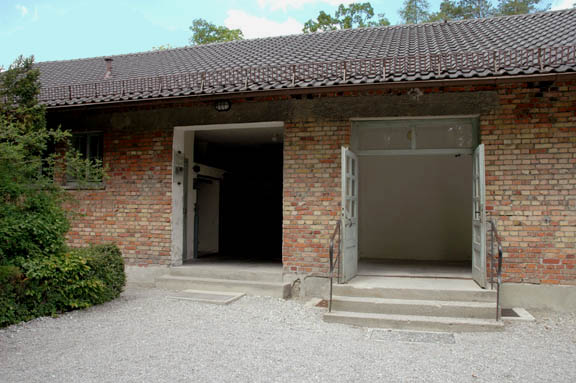 The photo above shows the south end of Baracke X, the gas chamber building. On the left is an open air hallway where the four disinfection chambers are located. The homicidal gas chamber is in the center of the building. The door on the right in the photo above opens into a vestibule from which the victims entered the waiting room and proceeded to the undressing room before going into the gas chamber disguised as a shower room. After Dachau was liberated on April 29, 1945, the official report of the US Seventh Army was printed as a book entitled Dachau Liberated: The Official Report by The U.S. Seventh Army, Released Within Days of the Camp's Liberation by Elements of the 42nd and 45th Divisions. The Report was based on two days of interviewing 20 political prisoners at Dachau; the prisoners told the Americans that both the shower room and the four disinfection chambers were used as homicidal gas chambers. The following quote is from The Official Report: "When the American troops arrived on 29 April 1945, there were approximately 32,500 estimated internees of all nationalities, the Poles predominating. During this period, the camp was notorious for its cruelty, but within the last six or eight months, some 'token' improvement was noted in the treatment of the internees. However, the new crematorium was completed in May 1944, and the gas chambers, a total of five, were used for the executions and the disposals of the bodies." The Baracke X building and the five gas chambers were actually completed in May 1943. The Report of the Atrocities Committed at Dachau Concentration Camp, signed by Col. David Chavez, Jr., JAGD, 7 May 1945 is quoted below: "The new building had a gas chamber for executions... the gas chamber was labeled "shower room" over the entrance and was a large room with airtight doors and double glassed lights, sealed and gas proof. The ceiling was studded with dummy shower heads. A small observation peephole, double glassed and hermetically sealed was used to observe the conditions of the victims. There were grates in the floor. Hydrogen cyanide was mixed in the room below, and rose into the gas chamber and out the top vents." 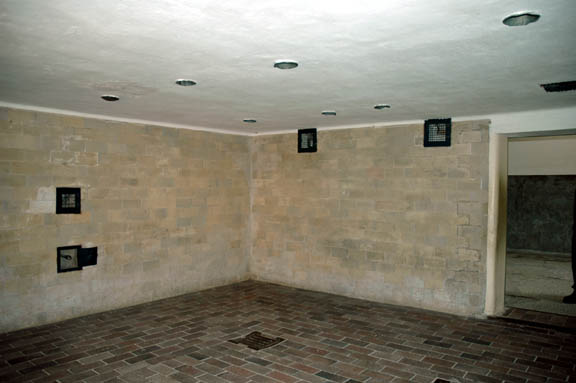 The photo above shows two light fixture boxes on the north wall, just below the ceiling in the gas chamber. These are the "top vents" described in the Army Report. On the ceiling are empty holes from which the "dummy shower heads" were stolen by souvenir hunters. On the far right in the photo is the door into the morgue which is conveniently next to the gas chamber. In the center of the photo above is one of the six "grates in the floor." These "grates" look like floor drains that have been closed up. On the left, in the photo above, is the "small observation peephole" with a water pipe in another box below it. This water pipe might have been used to hook up a hose to clean the morgue room adjacent to the gas chamber, since the morgue does not have any source for running water. The peephole in the gas chamber is not at eye level for a man six feet tall. Note the bricks on the left side of the peephole which do not match the rest of the bricks; the frame around the peephole does not match the frame around the water pipe. On May 3, 1945, a film crew took movie footage of the Dachau camp, which was shown at the Nuremberg International Military Tribunal on November 29, 1945. The section of this film which shows the Dachau gas chamber explains how the victims were killed. Large pipes and control wheels behind the west wall of the gas chamber are shown in the film while the narrator says "A man at the controls let in the poison gas." The openings on the east wall where the gas pellets could have been poured onto the floor of the gas chamber, according to the staff at the Dachau Museum, are not shown in the film. The photo below, which was taken in 1945 shortly after the Dachau camp was liberated, shows the pipes and control wheels behind the west wall of the gas chamber which were featured in the film shown at the Nuremberg International Military Tribunal on November 29, 1945. In the center of the photo below is a rectangular panel with push buttons which is approximately at shoulder level for a man six feet tall. Just below the push button panel is a small round peephole with its cover lifted up. To the left of the push buttons and the peephole is a switch box with a handle that can be thrown to let something "Aus" or "Ein" which in English means Out or In. On the far left and on the right in the photo below are the wheels that the operator turned to let the gas in through the three rows of pipes. However, there were no openings for the gas on the ceiling of the gas chamber, since the shower heads were not connected to the gas pipes. 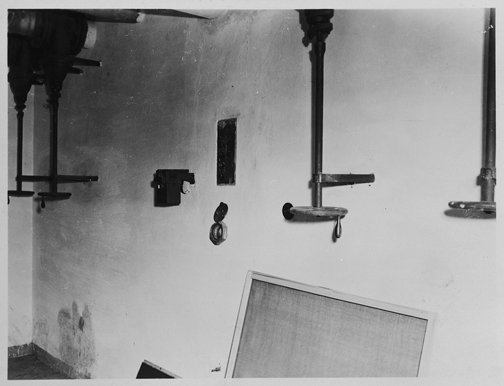 Copyright: USHMM A closeup of the panel in the center of the photo above shows that it has four push buttons, but the narrator does not explain what the buttons were for. There are four sets of lights in the gas chamber which might have been turned on and off by these buttons. However, in the film shown at Nuremberg, which was made by the American Army on May 3, 1945, four of the light fixture boxes are called "top vents" through which the gas was put into the room. A display in the undressing room in May 2007 informed visitors that the push buttons were stolen after the camp was liberated. The area behind the west wall of the gas chamber, which is shown in the photo above, is off limits to visitors now. The "top vents" that were mentioned in the Army Report were four of the light fixture boxes from which the light fixture had been removed, as shown in the photo below. 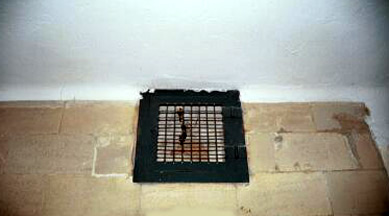 One of "top vents," which is flush against the 7.6 foot ceiling, is shown in the photo above, taken in May 2003. This empty light fixture box is called a "gas vent" in the film clip of Dachau that was made by Hollywood director George Stevens on May 3, 1945 and shown at the Nuremberg IMT on November 29, 1945. This YouTube video shows the "top vents." The film of the Dachau gas chamber was just a small part of an hour-long movie that started with the burning of concentration camp prisoners in a barn at Gardelegen and covered all the major Nazi atrocities including the lamp shades made out of human skin at Buchenwald and the emaciated bodies of typhus victims being pushed by a bulldozer into mass graves at Bergen-Belsen. The photo below, taken in May 2007, shows one of the light fixtures in the gas chamber. This is one of the "double glassed lights, sealed and gas proof" which were mentioned in the Official Army Report. The light fixture box is flush against the 7.6 foot high ceiling. In May 2007 when this photo was taken, there was no glass in the light fixture box, as described in the Army Report. 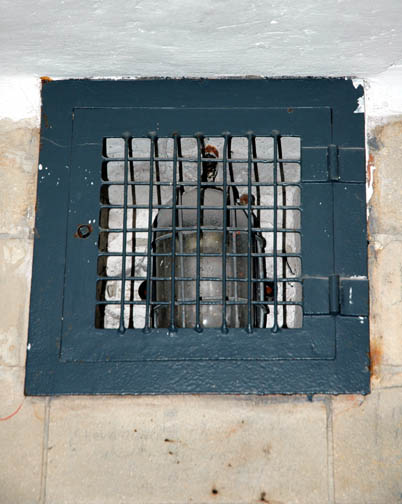 In the photo above, notice that there is a bit of white paint on the right side of the blue light fixture box. Would it have killed the Germans to have used a bit of masking tape to avoid this? Curiously, the Germans, who are noted for neatness, tolerated this sloppy paint job for two years. The photo below shows the door into the Brausebad (shower bath) which is right next to the morgue where corpses were stored at Dachau. The placement of a shower room next to the morgue room was not unusual in the Nazi concentration camps. According to a book entitled "Auschwitz, a Doctor's Eyewitness Account," written by Dr. Miklos Nyiszli, a prisoner who worked as a pathologist in one of the crematoriums at Auschwitz, "Those who worked with corpses had to wash frequently, so showers were mandatory twice a day, a regulation to which we all gladly submitted." However, the shower room in the Dachau crematorium was not functional; it was a gas chamber disguised as a shower room. The word "Brausebad" was pasted on the wall above the door to make the prisoners think that this was a "shower bath."
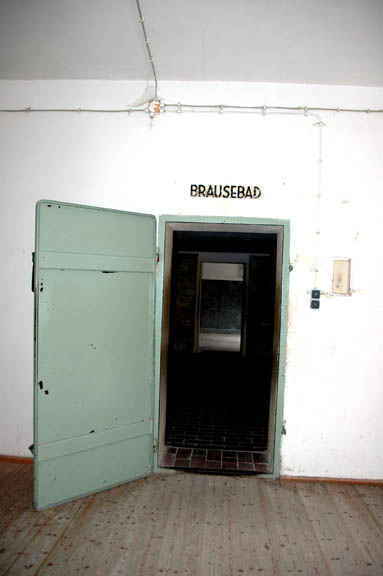 The door, shown in the photo above, cannot be moved because there is a nail on the floor holding it in the open position. On the wall and ceiling above the door are exposed electrical wires. In the film that was shown at the Nuremberg IMT on November 29, 1945, a US soldier can be seen opening the heavy steel door, shown in the photo above, that separates the undressing room from the gas chamber. The first thing we see, on the wall opposite the door, are two "gas vents," one of which is shown in the color photo above. Then we see a "gas nozzle" which looks like a shower head stuck into the concrete ceiling with no visible pipes.  A large square vent located just above the floor on the west wall of the gas chamber is shown in the film, but not the openings for the bins near the floor on the east wall. The film shows the large pipes and control wheels that are in the "engineer's room," behind the west wall of the gas chamber and an unopened can of Zyklon-B pellets which is called "cyanide powder." The film shows a sign on the wall of the morgue that reads "Reinlichkeit is hier Pflight deshalb Hände waschen nicht vergessen." In English, this means "Cleanliness is a duty here, therefore don't forget to wash your hands." This sign has now been painted over. The film that is available on the USHMM web site is raw footage with no sound, but the transcript of the narration about the gas chamber in the finished movie is quoted below: This is the Brausebad -- the shower bath. Inside the shower bath -- the gas vents. On the ceiling -- the dummy shower heads. In the engineers room -- the intake and outlet pipes. Push buttons to control inflow and outtake of gas. A hand-valve to regulate pressure. Cyanide powder was used to generate the lethal smoke. From the gas chamber, the bodies were removed to the crematory. According to a book published by the US Seventh Army immediately after the war, entitled "Dachau Liberated, The Official Report by The U.S. Seventh Army," there was a total of 29,138 Jews brought to Dachau from other camps between June 20, 1944 and November 23, 1944. This report says the Jews were brought to Dachau to be executed and that they were gassed in the gas chamber disguised as a shower room and also in the four smaller gas chambers, which the staff at the Dachau Memorial Site now claims are delousing chambers. By November 1945, it was known that the 29,138 Jews brought to Dachau from other camps between June 20, 1944 and November 23, 1944 had been transferred to the eleven Kaufering sub-camps of Dachau to work in munitions factories and had not been gassed in the five gas chambers at Dachau, as stated in the Official Army Report that was written within days after the camp was liberated. The photo below shows a machine in one of the "four smaller gas chambers" that was supplied by the DEGESCH company which manufactured the Zyklon-B pellets used for gassing the Jews and also for disinfecting the clothes. The bar at the top of the photo was used to hang the clothes on hangers. 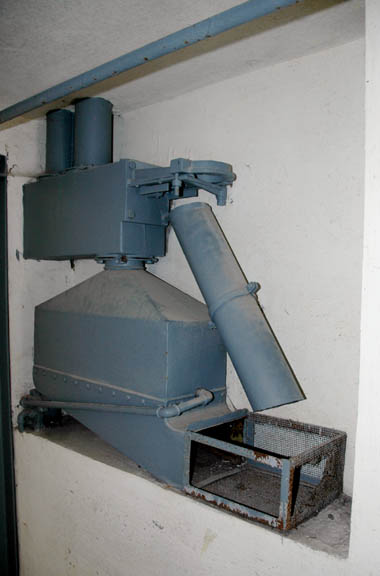 The machine which is shown in the photo above automatically opened a can of Zyklon-B and dumped the gas pellets into a wire basket where hot air was blown over them to speed up the release of the poison gas. The walls of the disinfection chambers have been painted so that the blue stains that are characteristic of Zyklon-B use can no longer be seen. On 3 May 1945, the same day that the film of the gas chamber was made, American congressmen toured the Dachau camp and stood in the largest gas chamber, examining its fake shower heads. Their Congressional Report, based on this visit, was entered into the International Military Tribunal at Nuremberg as evidence that a homicidal gas chamber was used to murder prisoners at Dachau. An affidavit given by Dr. Franz Blaha, a prisoner at Dachau, to Col. David Chavez on 3 May 1945 was entered into the proceedings of the Nuremberg International Military Tribunal. Except for the film of the Dachau gas chamber that was shown at Nuremberg on November 29, 1945, Dr. Blaha's testimony was the only evidence that prisoners had been gassed at Dachau and the verdict at Nuremberg did not mention the Dachau gas chamber. Evidence of gassing at DachauHistory of Dachau gas chamerBack to Gas Chamber indexBack to Dachau indexHomeThis page was last updated on October 13, 2009 |
